

| Home | For sale | Site map | Contact information | Guest book | Stielhandgranate 24 menu |
 Stielhandgranate
43 Stielhandgranate
43  |
|---|
|
The change to the Stielhandgranate 43  By 1942 the combined yearly output of all manufacturers of the Stielhandgranate 24 had reached a total of 5.912.000 pieces, but production capacities had reached its limit. Simplifications of the existing design had eased some of the burdens, but they were simply not enough. A whole new design was needed to save both labor hours and raw materials. The simplified model was designated Stielhandgranate 43 and it was announced in the "Heerestechnische Verordnungsblatt" dated 1 May 1944. The production started in 1944 and continued into 1945. The change in production from the Stielhandgranate 24 to the Stielhandgranate 43 must have taken place quite rapidly for all of the manufacturers. Metallwarenfabrik Hermann Nier, Beierfeld, code fcc was the last one to change production from the old to the new model. 1944 dated Stielhandgranate 24's are scarce, with fcc 44 marked ones being the most common maker.  The main modification was the simplified handle. The new handle saved the industry from drilling out 6 million handles yearly and the manufacturing and installation of 6 million safety caps, porcelain balls, strings, rain caps and thread caps each year.  The new handle simply had a metal cap with pressed threads crimped to the end of the handle. Some of these caps can be found painted in Dunkelgelb, but most have a phosphate finish. Most handles, but not all, had a hole drilled through the handle. This detail is not mentioned in the official announcements about the Stielhandgranate 43, so the official purpose is not known, but it would be helpful as an anchorage if the Stielhandgranate 43 was to be used as a booby trap. The lower cover plate of the head was solid with stamped threads set in a well that would accept the handle. The head could be carried and thrown like the Eihandgranate 39 by removing the handle.  The detonator channel was no longer attached to a separate lid, but was now spot welded or crimped directly to the top of the head and had internal threads to accept the fuse. 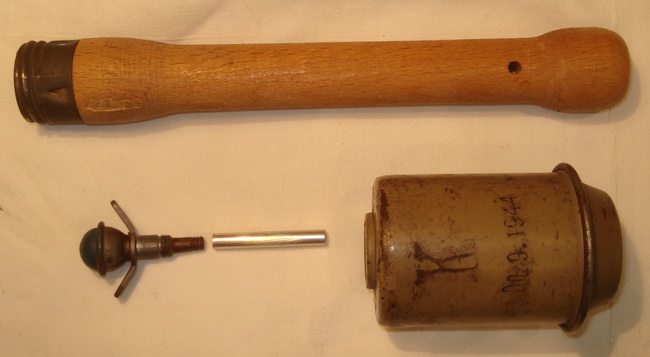 All the parts of the Stielhandgranate 43 laid out. The head was assembled in the same way as the Stielhandgranate 24. The waxed paper bag with the explosives was placed inside the head and the lower cover plate, with the threads for the handle, was crimped in place. Although the constructional drawing shows an additional cover plate in the bottom, inspections of opened surviving examples reveals that this was not installed at the factory. 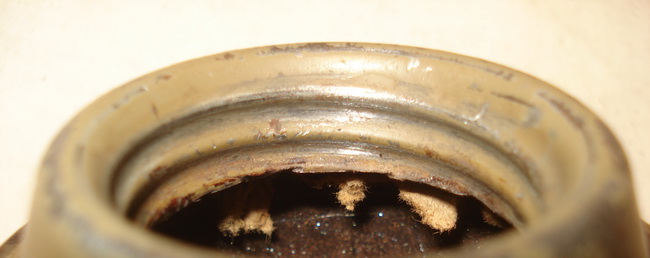 On this Stielhandgranate 43 head the bottom of the handle well has been cut out by a collector in order to remove the explosives. Note the remnants of the waxed paper bag that once held the explosives. 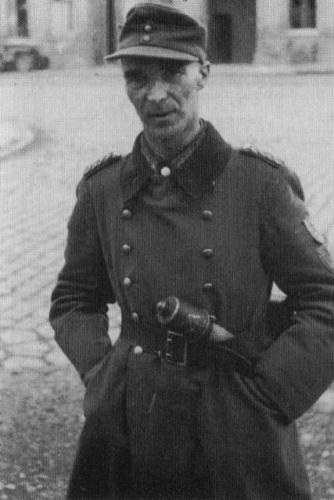 General Rudolf von Bünau during the defense of Vienna, armed with a Stielhandgranate 43 Apart from the much simplified manufacturing process the new model also had the advantage of much better and easier waterproofing. The head was hermetically sealed and the fuse was screwed into the fuse channel sealing off the access to the Sprengkapseln once installed. The Stielhandgranate 43 was also claimed to be easier to handle, with the fuse in the top of the head. 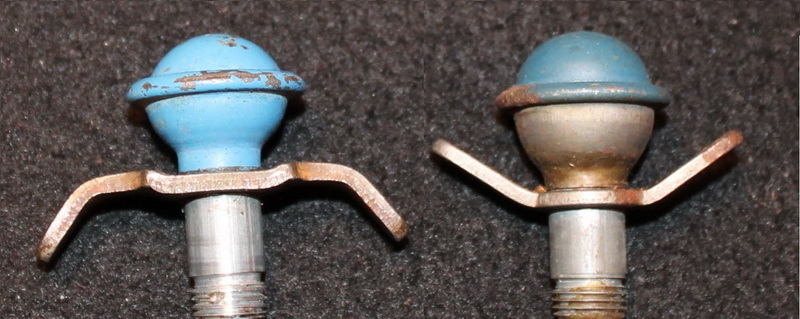 The Brennzünder 24 was replaced with the Brennzünder für Eihandgranaten 39 with modified wings. The Brennzünder für Eihandgranaten 39 had down folded wings that would follow the contour of the egg, but would not have fitted the head of the new Stielhandgranate 43. The quick-fix was just to turn the wings upside-down. The sole mission of the wings was to assist in the mounting and removing of the fuse.  The Brennzünder für Eihandgranaten 39 worked on the same principle as the Brennzünder 24. Pulling the friction wire through the friction composition contained in the capsule would result in a flame that ignited the delay pellet (black cylinder in the picture above). When the delay pellet burned through, it ignited the detonator. In December 1944 a new fuse was introduced to replace the Brennzünder für Eihandgranaten 39, the Brennzünder 40. Outwards the fuses looked identical, but the ignition system was completely different. The Brennzünder 40 consisted of a spring loaded striker and a small percussion cap. A strong pull on the rope causes the striker release plate to be drawn from the igniter body, carrying with it the striker and compressing the striker spring. When the release plate is withdrawn fully from the igniter body, it disengages from the striker and the striker is released. The compressed striker spring then forces the striker to impinge upon the percussion cap. The percussion cap will then ignite the delay pellet, burning for 4.5 seconds. The problem with both the Brennzünder 24, the Brennzünder 39, the Brennzünder 39 (umg.) and the Brennzünder für Eihandgranaten 39 had been the "soft firing", written as the warning "mit weicher Abfeuerung" on the boxes. The soldier igniting the handgrenade would have no warning to tell him if he had in fact succeeded to ignite the delay pellet, leading to fatal accidents. The new Brennzünder 40 would give off a sharp sound when the striker ignited the percussion cap, actually saving lives! Both the Brennzünder für Eihandgranaten 39 and the Brennzünder 40 had a blue head (Blaukopf), denoting a 4,5 second delay.  The Brennzünder für Eihandgranaten 39 and the Brennzünder 40 looks identical on the outside. To tell them apart the ball has to be unscrewed, and the anchorage for the pull string inspected. The Brennzünder für Eihandgranaten 39 will have a coiled wire and the Brennzünder 40 will have a stamped striker release plate instead. 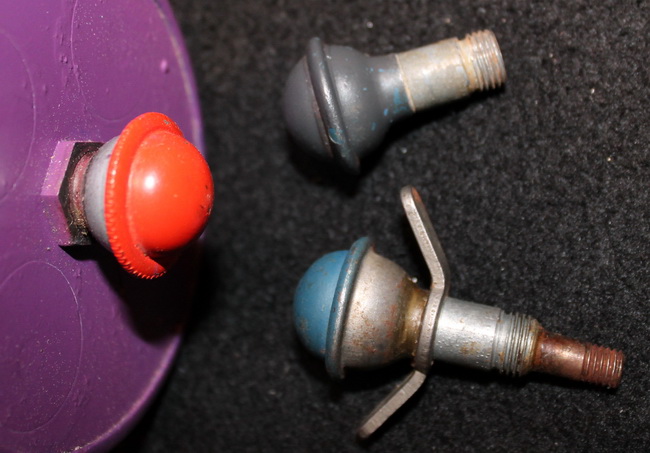 Different versions of the Brennzünder. Red head (Rotkopf) has a 1 second delay, mostly used in boxes of colored smoke and message boxes dropped from aircraft, but also used in booby traps. Gray head (Graukopf) was instant, used for demolition work, booby traps and ignition of black powder fuses. Blue head (Blaukopf) had a 4.5 second delay, used in different types of handgrenades. 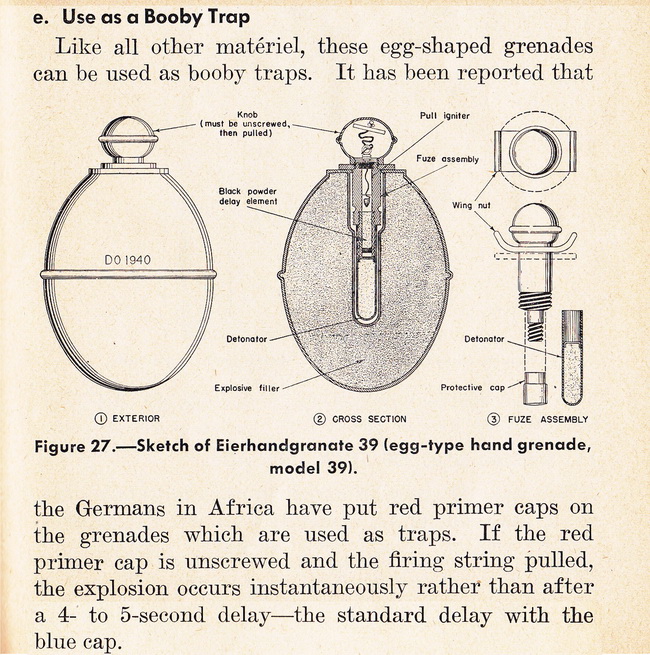 A page from the publication "German Infantry Weapons", prepared by Military intelligence service, dated May 25 1943. It accurately describes the use of the Brennzünder with a red head as a booby trap, although the delay time would be 1 second, and not "instantaneously". 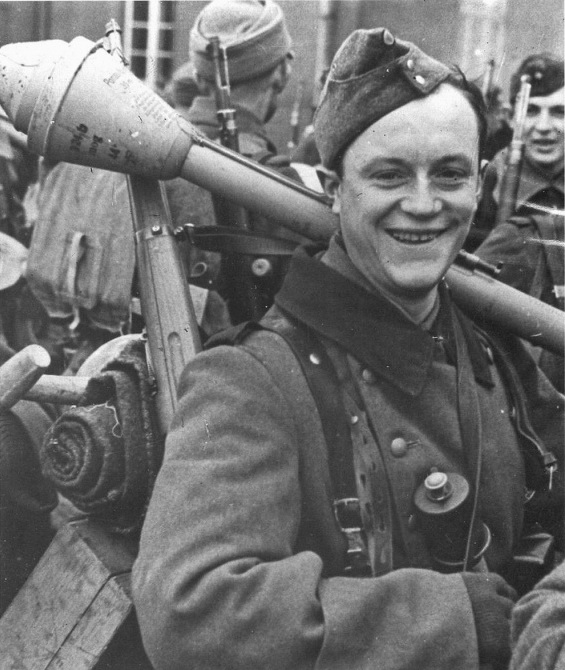 The Stielhandgranate 43 was mainly delivered in Dunkelgelb (tan) color, but the first examples made by at least one manufacturer came in the same ordnance green color as the Stielhandgranate 24. The only maker I have registered so far painting them green was evy, Wilhelm von Hagen Metallwarenfabrik, Iserlohn Westfalen. The one pictured above is clearly green. 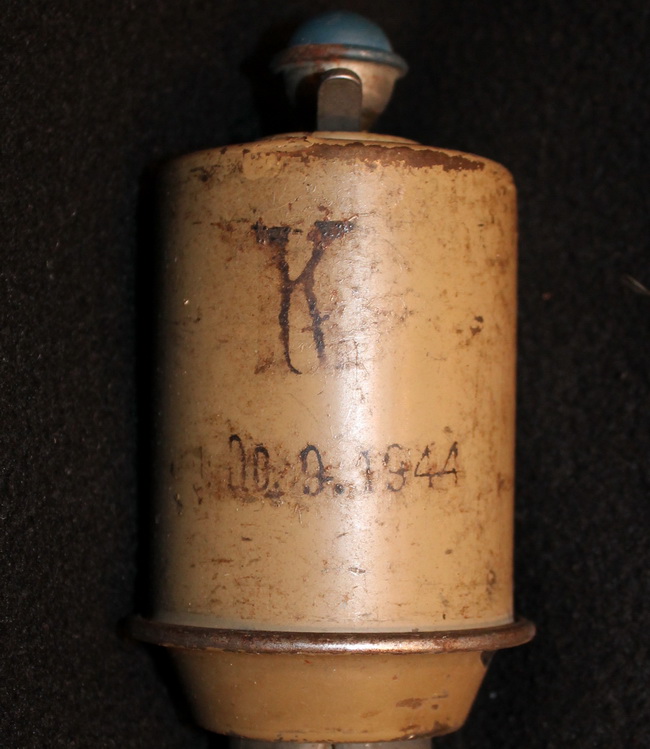 The markings followed the same pattern as the Stielhandgranate 24, with black ink denoting the explosive contents. "K Do 9/1944" should translate to "Approved for use in cold weather, filled with Donarit, made in September 1944".  The maker code and year of production was metal-stamped both to the top and the bottom of the head, and burnt or pressed into the handle. Registered manufacturers of the Stielhandgranate 43 so far includes aqj, bdp., brb, dol, evy, eyu, fcc, flf, ftd, gck, wc and prd. I am sure there are even more makers than those listed here. prd is a "second generation code", and not a new maker. The code was assigned as a new code to a company already registered under a different code towards the end of 1944. By studying surviving handles for the Stielhandgranate 43 the best match is brb, so until further information surfaces I hold it likely that prd is the late war code for Richard Rinker G.m.b.H. in Menden/Iserlohn. Note the big individual differences of the handle between the different manufacturers.  For further details about the makers, see the page about each individual manufacturer. 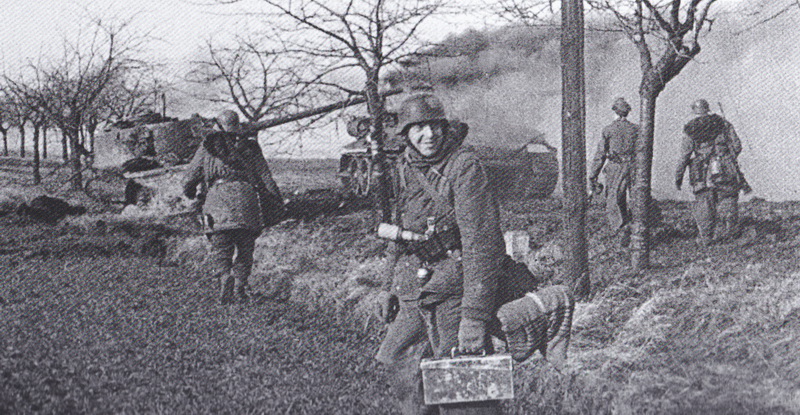 Panzergrenadiere during a counter attack near Pyritz, East Prussia in the beginning of February 1945. The picture is from a film strip made by Transit film GmbH. Note the tan colored Stielhandgranate 43 in the Grenadier's belt. The Übungs-Stielhandgranate 43? What happened when the factories changed their production from the Stielhandgranate 24 to the new model, the Stielhandgranate 43? The soldiers still had to practice with their Übungs-Stielhandgranate before they were expected to use the real McCoy in combat. Plenty of surviving examples of 1944 dated Übungs-Stielhandgranate 24 indicates that the production of these continued regardless. The need for a Übungs-Stielhandgranate 43 was present, but the Übungs-Stielhandgranate 24 seems to have been used as a substitute. No manuals or contemporary documents mention such a device, and no photos show that they existed at the time.. But one example of what appears to be a Übungs-Stielhandgranate 43 has recently surfaced.  A Übungs-Stielhandgranate 43. Picture courtesy of Nick Jeans, UK. Since this is the only known example of a Übungs-Stielhandgranate 43 I assume this item never made it to mass production. It has no visible manufacturer's code, and has a even more simplified handle design. 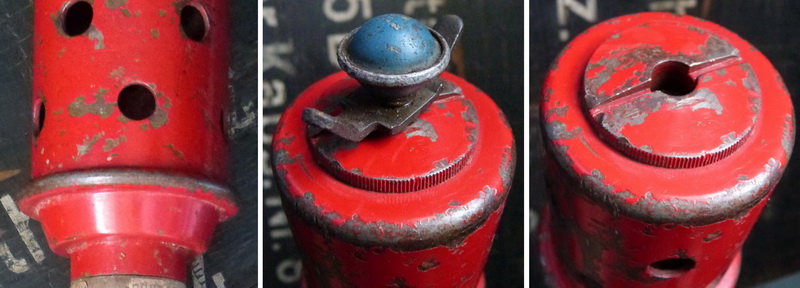 Picture courtesy of Nick Jeans, UK. The handle is shorter, lacks the "curves" of a "live" Stielhandgranate 43 and has been riveted directly to the head. The head has been made of thicker steel to withstand the gas pressure from the Übungsladung 30, and compensate for the weight since the explosives are missing. This in turn makes the crimped edge a lot bigger compared to a "live" Stielhandgranate 43. To allow the use of the Übungsladung 30 a separate lid with threads has been fitted to the top. 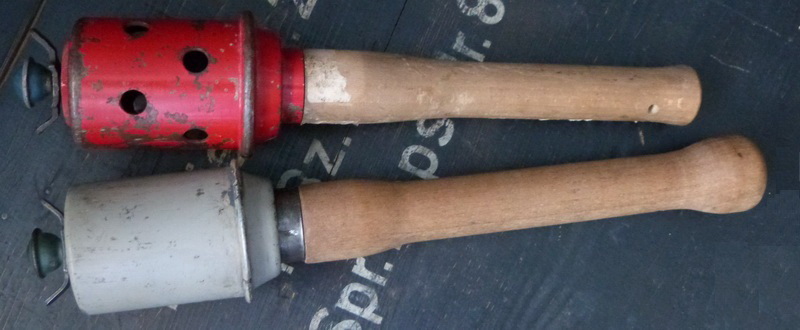 Picture courtesy of Nick Jeans, UK. I assume that this Übungs-Stielhandgranate 43 must have been a pre-production prototype or part of a very limited production for test & evaluation. I doubt these could have been made by unit Waffenmeisters, as the crimping of the baseplate to the head would require really heavy machinery. Go back to the Stielhandgranate 24 menu |
| Home | For sale | Site map | Contact information | Guest book | Stielhandgranate 24 menu |